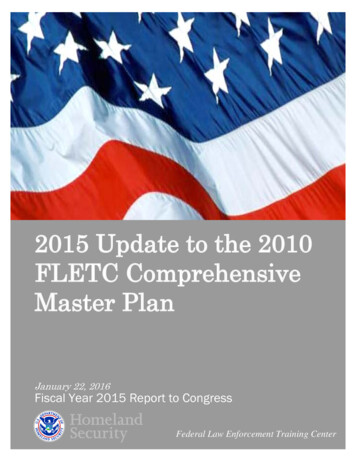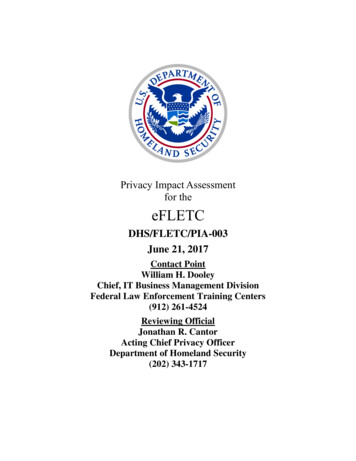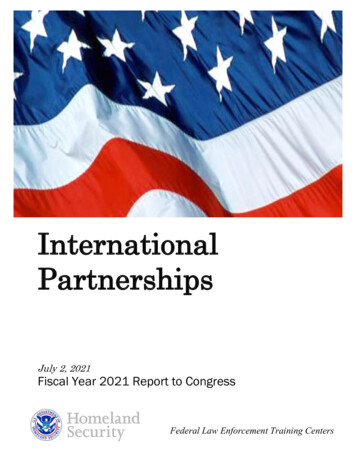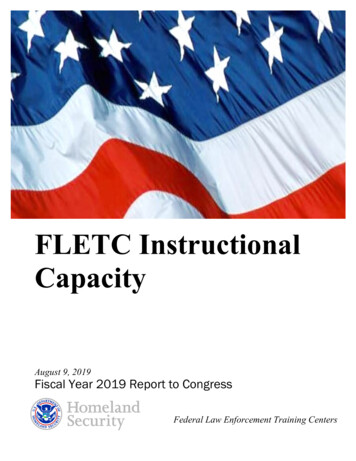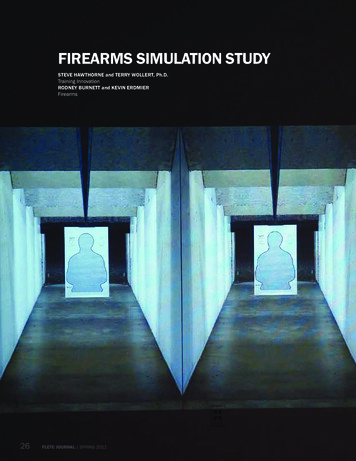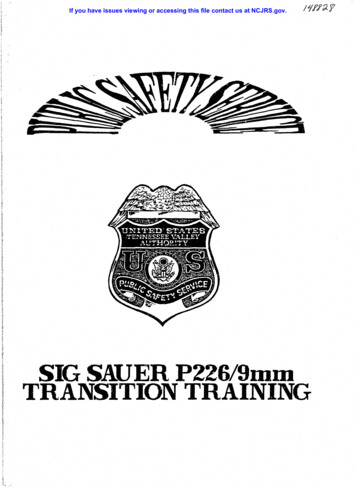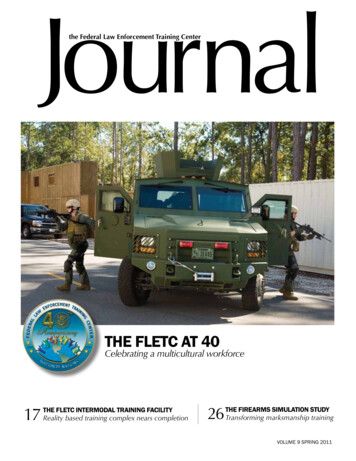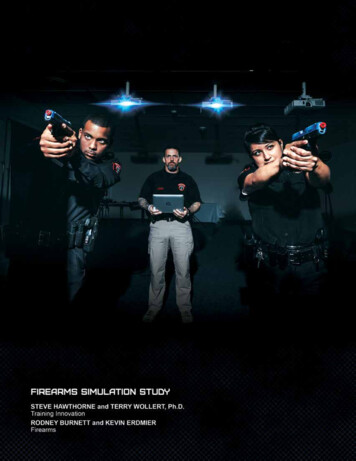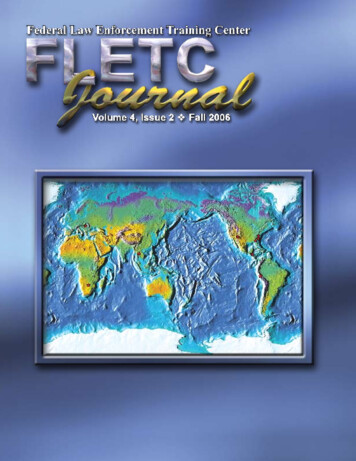
Transcription
FLETC Use of Force TrainingPlease examine the 9 posters included below andon the inside back cover of this issue.Also, note the articles concerning Use of Force trainingand applications on pages 22 and 33.
This IssueThe Dunlow Documents . .Managing The Paper Tiger .Welcome To FIT .They Don’t Look Like Monsters .De-Mystifying Distance Learning . .Electronic Control Devices:Liability And Training Aspects .Follow The Money . .FLETC Student EducationalEmployment Program (FSEEP)‘Pilot’ Summer Program .Use of Force .Domestic Violence Here at Home .The Law Enforcement AdvancedInterviewing Training Program(LEAINTP) . .59121619222731333845
The Editor’s DeskThe FLETC JournalDirectorConnie L. PatrickEditorsMarie R. BauerStephen W. BrooksRob GrayRichard HazzardWilliam Norris, Ph.D.Andy SmotzerSusan B. ThorntonMark WardFront Row (left to right): Andy Smotzer, Marie Bauer, RichardHazzard, and Susan B. Thornton; Back Row: Rob Gray,William Norris, Steve Brooks, and Mark Ward. Not picturedSam Webster.Cover DesignSam WebsterThe FLETC Journal is an unofficiallaw enforcement training magazineproduced and published by the FederalLaw Enforcement Training Center. Itis published and printed through theMedia Support Division in conjunctionwith the Government Printing Office.Circulation is 4,000 and the FLETCJournal is also available electronicallyby following the links at the FLETCwebsite at http://www.fletc.gov.Views and opinions expressed in thispublication are those of the authors,and do not necessarily reflect theFLETC training policy or doctrine.Articles, photographs, and othercontributions are welcomed from thelaw enforcement training communityand academia. Publication depends ongeneral topical interest as judged by theeditors. No changes to submitted copywill be made without the concurrenceof the author(s). The editors may becontacted at (912) 267-3849.The FLETC Journal’s mission is to provide a forumfor exchanging information and sharing perspectivesthroughout the law enforcement training community.The editors attempt to select a range of articles andnews items of interest to law enforcement trainers at allorganizational levels, from large institutional trainingcenters to small training departments. The Journal hasbeen available in print since our first issue in Spring2004, and to the FLETC staff and Partner Organizationsthrough our Intranet. We are happy to announce that theJournal will soon be available electronically from theFLETC website at ndtrainingvery seriously and strive for accuracy and integrity atall times. With this in mind, we must acknowledgeand apologize for an error in our last issue. The 2006Spring edition of the FLETC Journal listed an incorrectauthor for the article “What’s Up with All the Smoke?”The article was authored by Scott Wells, the FLETCForester/Natural Resources Manager. The correctedstory is posted in our on-line edition.Marie R. Bauer
The DunlowDocumentsBy Charles HuyckIt happens to every instructor who has spent morethan a few hours in the classroom or trainingenvironment. You have just presented someinformation to the class and suddenly your braindecides this would be a good time to interject apersonal account of an experience that happenedto you. Unfortunately, the tactical concept you’reproviding is not covered in the lesson plan. Themoment this thought takes place, you should seered lights flashing a warning signal of all thepossibilities and repercussions that could comefrom deviating from the lesson plan.It happened to me one day after teaching a classin the Physical Techniques Division at the FederalLaw Enforcement Training Center (FLETC). Agroup of students approached and popped thequestion, “Mr. Huyck, we’ve been learning allthis ‘Mickey Mouse’ stuff, how about you teachus some real stuff?” I responded, “What elsedo you want to learn?” A “choke hold” was thereply, with several other eager students chimingin their support. I hesitated while I collectedmy thoughts and scanned the otherwise vacantmat room. It was now just me and these fewenthusiastic students. The students pressed, asif they could read all the possibilities runningthrough my mind. “Yeah, a choke hold, you don’thave to teach us here in the mat room, we can goover to the Student Center and you can show it tous over there, after hours!”The students persisted, saying they were bored withall the basic defensive tactics they were being taught,and wanted to learn some “real street” survival tactics.I remembered in my basic training as a former U.S.FLETC Journal D Fall 2006DrugEnforcementAdministration (DEA)SpecialAgent, the defensive tacticscurriculum included the carotid restraint as alegitimate defensive tactic. However, the FLETCdefensive tactics curriculum did not. Luckily,the warning lights switched on and I responded,“If I show it to you, then I taught it to you, and itdoesn’t matter if we are in the classroom or out ofthe classroom. A choke hold is not an approveddefensive tactic per FLETC curriculum.”Before you think I’m being overly cautiousor too concerned with teaching within theguidelines of the approved lesson plan, let meintroduce you to Mr. Mike Dunlow. Mikeis a former Internal Revenue Service SpecialAgent and current re-hired annuitant assignedto the Enforcement Operations Division (EOD)at the FLETC. The “Dunlow Documents” asI have termed them, is proof that every wordyou say and every concept you teach under theauspices of a professional law enforcementtrainer could be used against you in a courtof law! If this story doesn’t make you thinktwice about your classroom demeanor andinstructional responsibility, you may seriouslywant to consider other employment before thesubpoenas start coming in. As we used to sayin DEA, “somebody is going to get indicted; itis just a matter of time.”5
I first met Mike Dunlow after being transferredto the EOD in 2004. As Branch Chief for LawEnforcement Support in the EOD, I supervisedMike. It quickly became apparent to me thatMike was an outstanding instructor who tookhis duties very seriously – just how seriouslywill become even more apparent as you continuereading.On a dreary San Francisco morning in February2003, a Federal Protective Service (FPS) UniformedOfficer prepared for work and embarked for hisduty assignment at the federal building. Sometimeduring the day, he and another officer were in theirpatrol vehicle outside the federal building when theyobserved an exotic sports car speed by the buildingat a very high rate of speed. The officers initiated avehicle pursuit and stopped the car several blocksfrom the federal building. As the officers approachedthe vehicle, the suspect attempted to flee the scene.One of the officers opened fire on the vehicle, firingfour shots into the suspect’s left front wheel area inan attempt to prevent the vehicle from escaping.At first, Mike and I rarely conversed for more than afew minutes at a time, and mainly the conversationwould center around Mike’s needing a few hoursoff every now and then to hone his golf skills, or aleave slip to take some time to spend with familyand friends. We discussed a few lesson plansfrom time to time and he would provide me withThe officers filed a report of the shooting incident,insight and suggestions as how best to improve ourciting the incident took place on federal property,current course offerings.and that the shots were firedWe also discussed theto deter the driver of theweather (every employeevehicle from running overEvery word you sayand supervisor mustthe officers, not to preventand every concept youdiscuss the weather: it’sthe vehicle from escaping.teachundertheauspicesmandatory).A videotape of the federalbuilding and surroundingof a professional lawAllthesuperficialareas came into play, whichenforcementtrainercouldconversation changed oneprompted further reviewday when Mike came intoof the incident. A FPSbe used against you in amy office and told me heSpecial Agent was assignedcourtoflaw!would need some timeto review the facts and theoff the schedule to travelreport. It soon becameto San Francisco to serve as a witness in a trial.apparent that the officers’ report did not match the“A trial in San Francisco?” I questioned. Mikecircumstances as portrayed, and in fact, the incidenthad been out of the field for quite some time so Ihad taken place off of federal property.wondered what the trial was all about. He replied,“Well, do you have some time, this may take moreAs part of the review process, the officers involvedthan a few minutes?” Mike sat down in my officewere interviewed by the special agent. Duringand the story that unfolded literally astounded me.the interview, one of the officers confessed to thefact that they had filed a false report.Thirteen years ago, in June of 1993, Mike wasemployed by the Internal Revenue Service andIn the report filed by the FPS Special Agent, thedetailed to the Behavioral Science Division atagent did not mention the confession resulting fromthe FLETC. In this capacity, Mike had taught anhis interview of the FPS Officer. Not only did heInterviewing class and an Ethics and Conduct classomit the confession, but he also left other crucialto students enrolled in the Criminal Investigatorelements out of his report in an apparent attempt toTraining Program. The class went off without aconceal the truth. Within the year, the special agentglitch, another successful instructional period forwas indicted by a federal grand jury and chargeda top notch instructor. And then it happened with “knowingly concealing, covering up, falsifying6FLETC Journal D Fall 2006
and making a false entry in a record and documentwith the intent to impede, obstruct, and influence aninvestigation,” in violation of 18 U.S.C Sect. 1519.On May 27, 2005, the FPS Special Agent wasfound guilty of writing a false report after a weeklong trial. Sentencing was scheduled for theoffense, which held a maximum imprisonmentsentence of 20 years and a fine of 250,000.Found guilty and facing a maximum sentenceof up to 20 years imprisonment and a fine of 250,000. This is not a position where any ofus in the field of law enforcement want to findourselves! In desperation, the defense wentall out and focused part of their efforts on thetraining that the special agent had received at theFLETC some 13 years ago. To call in question thetraining that a special agent had been given wasone thing, but to call the specific instructor thathad provided that training was an eye opener anda shot heard around the world in the profession oflaw enforcement training.Most people do not recall much from 13 yearsago. However, for those in the law enforcementprofession, taking diligent notes and keepingfactual and accurate records is a priority. ForMike Dunlow, the “Dunlow Documents” provedinstrumental in shutting down this line of defenseby the special agent, and shed light on just howcritical it is to stay within the confines of thelesson plan when instructing.In April 2005, the phone rang in Mike’s office.It was FLETC Legal Counsel advising Miketo come over to their office to speak with twoattorneys from the Department of Justice (DOJ)Civil Rights Division. Their inquiry centeredon the subject matter and lesson plan that Mikeused to teach a class in 1993. It occurred to Mike,after the questioning from the DOJ attorneys,that apparently somewhere in the defense of thespecial agent the issue of falsifying a report was akey element, and the agent may well have statedthat he had been taught by his FLETC Instructorthat it was okay to omit certain aspects of aninvestigation in his report.FLETC Journal D Fall 2006As part of the agent’s defense, he alleged thatwhile attending classes at the FLETC, specificallyinterviewing and report writing, he had relied onthe skills he had been taught at FLETC to furtherthe investigation, which resulted in his omittingcertain facts of the case. A check of the trainingrecords revealed that Mike Dunlow had beenthe instructor for the special agent’s CriminalInvestigator Training Program (CITP) class 13years prior.The DOJ Attorneys wanted to know specificallywhat the agent had been taught. This is where Mikeproved his professionalism and set the standardfor all trainers in the field of law enforcement.The DOJ attorneys wanted to know what Miketaught about note taking, securing of notes, andthe documentation of confessions. Apparentlythe notes from the agent’s interview of the FPSOfficers were missing as well as the all importantconfession by one of the FPS Officers.Mike reviewed the report by the agent and it wasobvious to him that a confession had been madebut omitted from the report. Mike verified thatthe lesson plan he had utilized to instruct theCITP class of 1993 stated that all notes had to bekept until all court proceedings were exhausted inthe case. Mike also verified that the lesson planstated that no facts of an investigation were to beomitted in a case for any reason, especially the factthat someone had made a confession. Mike alsoconfirmed with the civil rights attorneys that hehad followed the lesson plan without deviation.7
What occurred next separates the men from theboys, so to speak. During preparation for the trial,the DOJ Attorneys asked Mike to locate the lessonplan from the FLETC archives that he had used toteach the class in 1993. Mike not only had a copyof the original lesson plan from 1993, but he alsohad copies of the slides he used to teach the classand notes he had taken on the class. The “DunlowDocuments” were in a file neatly stowed away inMike’s office. The “Dunlow Documents” wereevidence of the dedication and professionalismof Mike Dunlow, and the seriousness of whichhe took his responsibilities every time he taughta class of law enforcement students. I seriouslydoubt the fact that Mike retained all of theseoriginal documents went unnoticed by the judgeand jury hearing the case. The credibility thatMike brought to the courtroom with the “DunlowDocuments” was truly outstanding, as well as histestimony during the trial.The lessons to be learned from this story reachfar and wide into the profession of training lawenforcement officers. The story of the “DunlowDocuments” needs to be told, and re-told, on aconsistent basis to all who bear the responsibilityof training the next generation of law enforcementprofessionals. The best training is sometimesfound in reviewing the basics. It is known as thefundamentals of the game.So, be wise and remember to every now and thenreview the basics and fundamentals. If you do, thenthe next time you set foot in a classroom or get infront of an audience of law enforcement students,you will teach only that which is tried and proven,and only that subject matter contained within theconfines of the official lesson plan. All trainersshould learn from the “Dunlow Documents” thatit never hurts to keep diligent notes and records because you never know when you’ll need them.About the Instructor: Mike retired from theInternal Revenue Service after a distinguishedcareer as a Special Agent. Mike Dunlow stillenjoys teaching at the Federal Law EnforcementTraining Center as a reemployed annuitant inthe Enforcement Operations Division. Mikecan still be found on the links in his off hourssomewhere in the Golden Isles chasing thatever elusive “birdie.”About the Author: Charles Huyck is a formerSpecial Agent for the U.S. Drug EnforcementAdministration, former Instructor for theFederal Law Enforcement Training Center, andis currently a reserve Special Agent for the CoastGuard Investigative Service and Branch Chieffor the Enforcement Operations Division at theFederal Law Enforcement Training Center.8FLETC Journal D Fall 2006
MANAGING THEPAPER TIGERCase Organization and PresentationBy Judi LangfordConducting investigations used to be a processof following leads, obtaining information, andwriting a case report. Much like putting a puzzletogether, we started out with a referral and usedtraditional investigative techniques to “make thecase.” Unfortunately, much as the complexity ofour lives has increased, so have the cases that wework. With the advent of the electronic age, there isno shortage of information. The challenge is not incollecting information, but in organizing, analyzing,and retrieving it. Computers are here to stay, andwe should harness these tools not just as wordprocessors, but to assist in storing and making senseof the data. Software companies have sprung up tofill this niche, but there has been a lack of training,and many investigators simply do not have the timeor the resources to negotiate the new technology.Electronic case management is a fairly new field withnew advances being made almost daily. In addition,more and more courts and prosecutors are realizingthe benefits of digitizing cases and evidence, realizingthat this results in a significant saving in trial time.The subject of case organization can be broken downinto several areas: organizing and inventorying evidencedigitizing paper through electronic scanningindexing masses of records for easy retrievalstoring, analyzing, and compilingvisually diagramming the caseWithout organizational and analytical tools, theinformation obtained during complex investigationsbecomes unmanageable.In this article there are suggestions for tools to use in eachof these areas and examples of appropriate software areFLETC Journal D Fall 2006provided. This article is not meant to be an exhaustive listand is not an endorsement of any particular software. Thegoal is to give a broad overview of the tools available aswell as advantages and disadvantages of each. Factors toconsider before choosing a particular software are the typesof cases being worked, the skill level of the investigatorsand administrative support, the cost, and of course, theinvestigator’s most critical resource, time. In short, thereis no absolute right or wrong way to organize and present acase. Through training and some application, you shouldfind the approach that works for you. Flexibility is thekey to conducting a successful investigation.Organizing and InventoryingIf you are fortunate to work a case that easily fits ina standard file folder, then organizing it is a breeze.However, most investigations go beyond the filefolder stage very quickly and move into boxes, thenfile cabinets, then into storage rooms, and perhapsultimately into a warehouse. Time becomes a valuableresource for the investigator who needs to be ableto find a particular document or item quickly. Theinvestigator also needs to be able to answer some basicquestions about the document, such as, where did itcome from, what date was it received, where is it beingstored, who can testify to it, and what relevance to theinvestigation does it possess. The answer to organizingyour investigation is to employ an electronic database.The two most obvious choices available on mostgovernment desktop computers are Microsoft Exceland Microsoft Access. Other more sophisticated (andmore complex) tools include Oracle, SQL Server,MySQL, DB2, and Paradox. Increasingly, there arecommercial software available designed exclusivelyfor organizing cases. Some of these are CaseMap,WinForce, and Analysts’ Notebook. These highlyspecialized databases are designed to offer an organized9
way for storing, managing, and retrieving informationwith minimal training. Databases are actually muchmore powerful than spreadsheets in the way they areable to manipulate data. Here are just a few of thefunctions that can be performed on a database thatwould be difficult, if not impossible to perform on atypical spreadsheet: Retrieve all records from multiple sourcesthat match certain criteria Update records in bulk Cross-reference records in different tables Perform complex aggregate calculationsacross multiple data sourcesInventory (or IFI) a few times, a system will emergeof entering data to allow for the most efficient sortingand filtering. Experience has shown that when multipleusers interact with common data sets – or files –database programs are generally more expedient thanspreadsheetsAnother important and time-saving consideration isto request whenever possible that records be given toyou electronically. Certainly, there are instances whenthe original document is critical; for example, whena signature or notation is in question or the documentis to be examined forensically for fingerprints orauthenticity. However, having data in an electronicformat will usually save time since it can be importedinto your database without manual reentry.Not withstanding the admittedly broad limitationof spreadsheets, an investigator could certainly useMicrosoft Excel (for instance) quite effectively and it Identifying the items to be collected in the investigationwould accomplish most if not all of the functions needed is a critical process and one that should be addressed atin managing a typical case. Excel is easy to learn. Itthe earliest investigative stage. Although this can be adoes have some limitations in handling large numbers mundane and tedious process, it is the most important partof records, so if your case has or is likely to have overof case organization. Each item collected should have65,000 records, you would bea unique identifier, whichbetter served with anotherenables it to be retrievedmore powerful databasequickly and easily. ConsiderClarity of communicationprogram. In addition, Excelusing the term “ICN” (oris always the goal of caselacks security in that it onlyItem Control Number) tosaves files when commandedsignify this unique identifier.management.by the user to do so, as opposedThe form of this numberto a database program such asmay vary depending on theMicrosoft Access which savespreferences of a prosecutordata after each transaction. Access does, however, require or of the investigative organization. A generally acceptedsubstantially more training and experience.standard for the ICN is the use of three numerical digitsfollowed by a decimal and then three more digits. ThisThe bottom line is not that one program is better than theallows flexibility in the numbering process. Someother. There are times when it would be appropriate to investigators or prosecutors may want the use of lettersimport records fromAccess to Excel and vice versa. (Note: along with numbers. The important point is that thethese two sibling programs exchange data quite easily.) numbering system makes sense to the various users andOnce the investigator begins to collect a fair amount of allows for flexibility. Therefore, it is not recommendeditems, then they should begin to electronically inventory that the number placed on the boxes be included in thethem. A critical concept is to inventory EVERYTHING. ICN number. In addition, it is not recommended thatAll items received during the investigation should be search warrant or other numbers be included in the ICN.entered regardless of its relevance or importance. ThisHaving voluminous numbers defeats the purpose ofwill help assure a thorough and objective investigation. making this investigative process useful.The column headers for spreadsheets (or field names forthe corresponding database) are the categories that theIn applying a document or item numbering system, it isinvestigator will use to analyze the data. A question that recommended that similar things be grouped in the sameshould be asked at this point is who will be doing the category of numbers. For example, have you receivedinventory? If more than one individual will be assisting, several audits, reports, court documents, photographs,then it is imperative that all entries are done consistently. bank statements, etc.? Once you have received a numberThis is particularly true when using Excel as a database. of items (this is usually at the point when a single fileOnce the investigator has used this Investigative File folder will no longer hold all of them), look at the broad10FLETC Journal D Fall 2006
categories and apply a numbering system which willallow the most efficient way of analyzing through sortingand filtering. This will vary among investigators in thetypes of cases that they work. For example, an insuranceinvestigator and a money laundering investigator mayhave different types of documents and evidence althoughthey are both financial crimes investigators. This iswhy flexibility is so crucial in establishing a viablenumbering system. Once an investigator has, throughtrial and error, used a numbering system that has workedthroughout an investigation, then it can easily be usedin other investigations of the same type. A good systemof tracking all items collected in the investigation willquickly answer the questions, “What do I have?” and“Where is it?”Ideally, the investigator should number each item ordocument that is received. However, this is not alwayspossible. Therefore, the packet, folder, or containershould receive a number and then groups of itemsshould receive a sub-number within that category. Aparticularly relevant or significant item or documentshould definitely have its own number within the groupfor easy retrieval. This item could be inventoriedlater and receive a number at that time. For example,suppose the investigator receives a folder of documentsfrom an individual at a business. These records relate tomerchandise ordered by the business. The investigatorhas chosen the 600.000 series to represent businessrecords. Therefore, the inventory of this folder mightbe entered as 601.000 as the ICN, the Description fieldwould list “Company Name Folder,” Date Received,and the Source as who the folder was received from.Subsequently, specific documents found within thefolder would be assigned sub-numbers such as 601.001,601.002, 601.003 . Be mindful that the softwarewould see the numbers 601.1, 601.10, and 601.100 as thesame numbers mathematically. By correctly formattingthis field and entering the numbers accurately, thisconfusion would be avoided. It should also be notedthat whenever entering text into the inventory, the firstword entered should be the proper name or name thatwould provide the easiest and quickest sort.In addition to creating an inventory of everythingcollected in the investigation, there will most likelybe a need to create other types of databases as well.For example, subpoenas, witness lists, grand jurymaterial, discoverable items, exhibit lists, evidencelogs, and financial transactions should be entered andmade available for subsequent analysis. These separatedatabases may or may not “talk” or relate to each other.A legend sheet should be constructed that explains anyindustry-specific or otherwise ubiquitous acronyms.For example, does “MTG” stand for meeting ormortgage? Clarity of communication is always thegoal of case management.The Investigative File Inventory fields should fit onan 8.5”x 11” sheet, set up for landscape. The lateraldimensions of an IFI should allow an entire line to beentered and displayed. Although it is tempting to putin every possible field, having the inventory sheet printhorizontally on more than one sheet creates unwieldyinventories that will not serve the investigator well.It is recommended to enter a sheet of data into aninventory, review it, and then manipulate the data tosee if that format will be the most effective for thecase. It is better to make adjustments early in theprocess than wait until numerous sheets have alreadybeen created.Example of Investigative File InventoryICNLocationWitness(1)2.001File Tab 1Doe, inkNess, ElliotMOI & Notes1/20/1928EN1-SAEvidenceNess, ElliotDoc—Capone1.001Doe, John1/20/1928Smith, Doc 1Locker-SAfinances “ledger”3.001File Tab 2Ness, ElliotN/A-SAS-Operation1/29/1929SOPS1PlanNess, Elliot Borden, DavidS-Surveillance4.001File Tab 21/30/1929SLog1-SA-SAlogAgent NotesAlleges that Al Caponeis evading taxesProvided by Smithduring interview tosupport allegationsPresented to task force1/29/1929Capone meets Frank Nittithen boards planefor Floridacontinued on page 42FLETC Journal D Fall 200611
FORENSICS AND INVESTIGATIVETECHNOLOGIESBy J. O. SmithThe Forensics and Investigative TechnologiesDivision (FIT) of the Federal Law EnforcementTraining Center is working toward ensuring students aretrained in the newest and most innovative technologyas they move into their new careers. For the past 25years, counterterrorism and technology coexisted ina one-sided relationship. For the most part, those inlaw enforcement and those in the military adaptedthe technologies that were commercially and readilyavailable to their needs. However, September 11,2001, changed everything and FIT recognizes that anew and more proactive approach is needed to meetthe challenges of our times.FIT also recognizes that the popularity of televisionshows such as CSI, 24, and Law and Order, and thetelevising of high-profile trials, has produced more12sophisticated juries who expect the prosecution tointroduce trace evidence to prove a crime. FIT ispreparing students to meet that expectation by teachingthem how to properly find and collect the evidenceneeded to convince juries.In addition to offering a staff of highly trained andqualified instructors (in
2004, and to the FLETC staff and Partner Organizations through our Intranet. We are happy to announce that the Journal will soon be available electronically from the FLETC website at www.fletc.gov. We take our commitment to law enforcement and training very seriously and strive for accuracy and integrity at all times.

